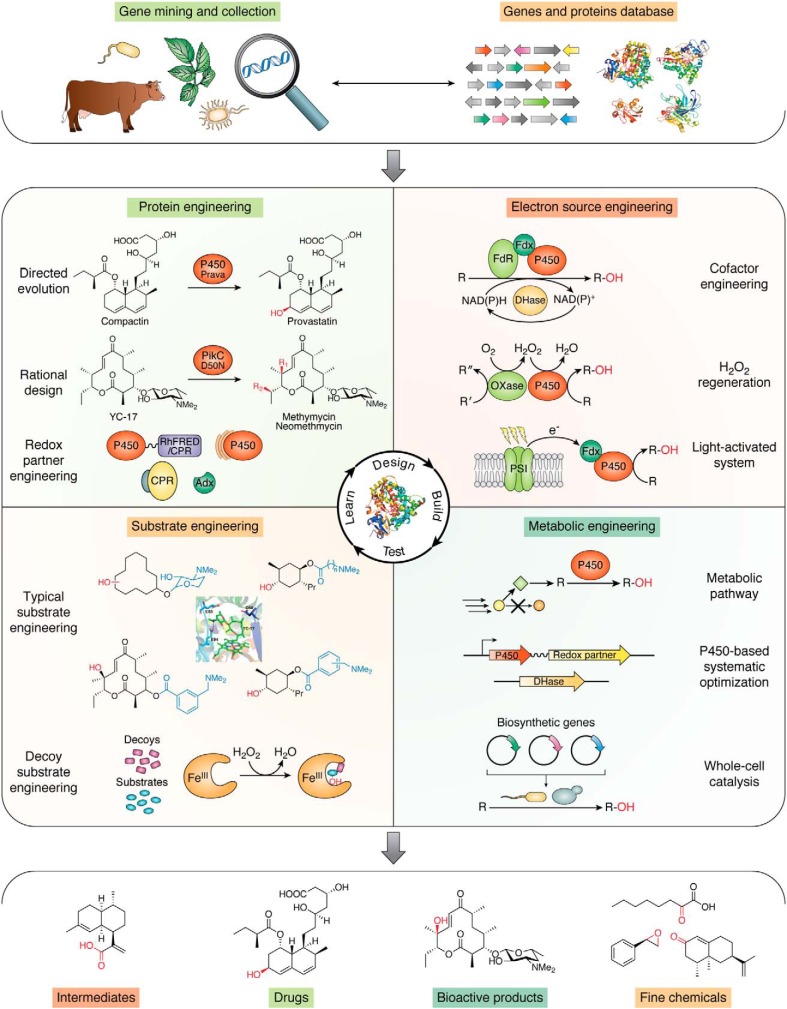CD Biosynsis is a leading research organization in the field of enzyme design and evolution, with long and in-depth experience in directed enzyme evolution. Our professional research team provides highly-quality services to help researchers improve enzyme-substrate reactivity and provide valuable insights for the rational design of enzymes with better properties or new functions.
Overview
Enzymes are biological catalysts that accelerate chemical reactions. Enzyme engineering is aimed to adjust the properties of enzymes and to modify enzymes in order to improve their performance so as to meet the demand for their specific functions. Enzyme engineering modifications include improving the catalytic activity, substrate specificity, stability and tolerance to harsh conditions.
 Fig 1. Engineering strategies for P450 systems. (Li Z, et al., 2020)
Fig 1. Engineering strategies for P450 systems. (Li Z, et al., 2020)
Our Services
Based on our advantages in the field of computer-aided design and AI applications, the EnzymoGenius™ platform aims to provide engineered enzyme designing services to help researchers in enzyme engineering applications.
- Rational Design
Rational design is a modification method based on intelligent computational strategies for modeling the kinetics and evolution of natural enzymes, by which target mutants can be screened more efficiently.
- Directed Evolution Design
Directed evolution is a widely used engineering strategy to improve the stability or biochemical function of target molecules through repeated mutation and selection. By artificially simulating the evolutionary process, diverse gene libraries are translated into corresponding gene product libraries, and functional variants are screened based on the correspondence between genotype and phenotype.
- Semi-rational Design
Semi-rational design refers to the fixed-point mutation, saturation mutation, and combined mutation of hot spot amino acids in the active center or the active pocket with the assistance of computer on the basis of a certain understanding of the physicochemical properties of the enzyme, the three-dimensional structure, the conformational relationship, the catalytic mechanism and other information. This method is between irrational design and rational design, overcoming the shortcomings of both and reducing the technical requirements.
- AI-assisted Design
AI-assisted design methods integrate machine learning algorithms, data analysis, and computational simulation which accelerate the entire enzyme engineering design process.
Applications
Our engineered enzyme design strategy can be used in a wide range of enzyme engineering applications.
- Biomedical Field: Designing enzymes for processing in synthetic biology, modifying enzymes in metabolic pathways, and designing enzyme preparations for scientific research or disease diagnosis.
- Food Manufacturing Field: Designing enzymes for raw material development to improve the quality of production processes in the dairy, brewing and fermented food industries.
- Fine Chemicals Field: Designing and modifying enzyme additives for the detergent industry, modifying enzymes for raw material processing in the textile and paper industries, modifying industrial membrane preparations for the petrochemical industry.
CD Biosynsis strives to offer comprehensive and reliable engineered enzymes for various applications, whether academic research, industrial applications, or biotechnological development, our services are tailored to meet your specific requirements. Our team is ready to assist you and provide the insights you need to achieve your goals. If you are interested in our services, please don't hesitate to contact us.
Reference
- Li, Z.; et al. Engineering cytochrome P450 enzyme systems for biomedical and biotechnological applications. J Biol Chem. 2020, 295(3):833-849.

































 Fig 1. Engineering strategies for P450 systems. (Li Z, et al., 2020)
Fig 1. Engineering strategies for P450 systems. (Li Z, et al., 2020)